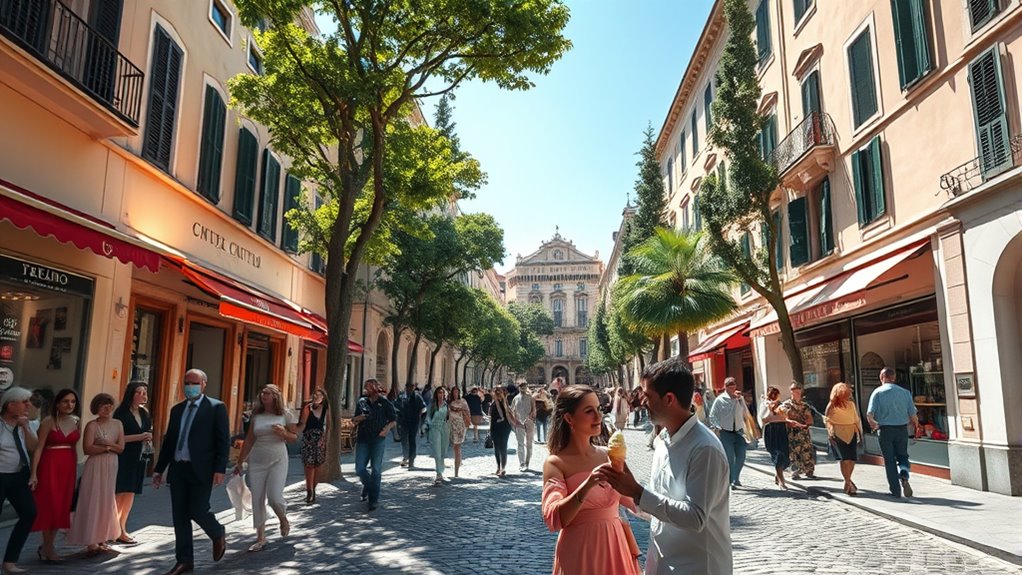The passeggiata is a beloved Italian tradition where you enjoy a Sunday evening stroll, turning ordinary walking into a lively social event. During this time, you’ll greet neighbors, share smiles, and stop for gelato at local cafes. It’s a simple, accessible way to connect with your community and unwind after the day. If you keep exploring, you’ll discover even more about how this charming ritual fosters bonds and enriches everyday life.
Key Takeaways
- The passeggiata is a cherished Italian evening tradition involving leisurely walks and socializing, often ending with gelato.
- It typically occurs in the early evening, creating a lively atmosphere with neighbors greeting each other.
- The tradition emphasizes community bonding, with stops at cafes or gelato shops for treats and conversation.
- Participating in the passeggiata fosters a sense of belonging and allows people of all ages to connect.
- It transforms everyday strolling into a meaningful cultural experience that celebrates local life and social interaction.

Have you ever wondered why a simple walk can become a cherished tradition? In Italy, the passeggiata embodies this idea perfectly. It’s more than just strolling through the streets; it’s a daily ritual that brings communities together and transforms an ordinary evening into a lively social event. During these walks, you’ll notice locals greeting neighbors, exchanging smiles, and catching up on the day’s news. This practice turns into a form of local socializing that strengthens bonds and creates a sense of belonging. The passeggiata usually takes place in the early evening, after work hours, when the streets come alive with movement and chatter. It’s a cornerstone of Italian evening rituals, helping people unwind and connect after a busy day. As you walk, you’ll see people stopping at cafes or gelato shops, making it easy to indulge in a sweet treat while enjoying the lively atmosphere. The act of strolling isn’t just about exercise or leisure; it’s a cultural tradition that fosters community and conversation.
The beauty of the passeggiata lies in its simplicity. You don’t need elaborate plans or special equipment—just comfortable shoes and an open mind. As you join locals on their evening ritual, you quickly realize how this tradition encourages interaction. Whether you’re a visitor or a resident, participating in the passeggiata can make you feel part of something larger. It acts as a daily gathering, where conversations flow freely, and the streets serve as a communal living room. The social aspect is integral, and you’ll find that everyone from young children to elderly residents takes part. This sense of shared experience turns an ordinary walk into a vibrant event filled with laughter, greetings, and spontaneous chats. It’s during these moments you understand why Italians hold their evening rituals in such high regard—these walks are about more than just moving through space; they’re about connecting with others. The local socializing that happens during the passeggiata encourages a sense of community, making neighborhoods feel warm and welcoming.
When you participate in a passeggiata, you’re not only observing a cultural tradition but also becoming part of it. It’s a simple yet powerful way to experience local life. The joy of strolling through scenic streets, stopping for gelato, and exchanging friendly conversations creates lasting memories. This tradition exemplifies how small daily acts can build a strong sense of community, turning an everyday activity into a cherished ritual. So next time you find yourself in Italy, embrace the evening ritual of the passeggiata—you’ll see how it transforms an ordinary walk into a meaningful social experience that captures the heart of local life.
Frequently Asked Questions
How Did the Passeggiata Tradition Originate Historically?
You might find it fascinating that the passeggiata originated in Italy during the Renaissance as a social and leisurely activity. Its historical origins lie in the desire for community connection and public display, especially among the upper classes. Over time, it gained cultural significance as a daily tradition promoting social bonding, relaxation, and appreciation of local surroundings, making it a cherished part of Italian life that continues today.
Are There Regional Variations in the Passeggiata Practice Across Italy?
Yes, there are regional variations in the passeggiata practice across Italy. You’ll notice differences in regional attire, reflecting local traditions and climate, as well as the choice of local landmarks where people gather. In northern towns, you might see more formal dress and scenic squares, while southern areas favor casual outfits along coastal promenades. These variations highlight Italy’s diverse cultural landscape and how each region uniquely embraces the passeggiata tradition.
What Are the Typical Social Customs During a Passeggiata?
During a passeggiata, you follow social customs like dressing according to fashion trends and maintaining good social etiquette. You walk leisurely, greet acquaintances with a nod or smile, and engage in friendly conversations. It’s common to observe proper manners, such as respecting personal space and waiting your turn to chat. You’ll notice locals often carry themselves confidently, blending style and respect, creating a warm, communal atmosphere during this cherished tradition.
How Has Modern Life Affected the Passeggiata Tradition?
You might think urban development and digital influence would kill the passeggiata, but surprisingly, they’ve just made it more ironic. Instead of leisurely strolling, you’re glued to your phone, yet still walking past cafes, shops, and fellow locals. The tradition’s adapted—less socializing face-to-face, more virtual connection—so your modern passeggiata is less about community and more about Instagram-worthy moments, even amidst the chaos of city life.
Can Visitors Participate in a Traditional Passeggiata?
Yes, you can participate in a traditional passeggiata. Locally organized events invite tourists to join in the leisurely walk, allowing you to experience authentic Italian culture. During these strolls, you’ll see locals socializing, enjoy gelato, and soak in the vibrant atmosphere. Participating offers a unique chance to connect with the community, observe daily life, and appreciate Italy’s cherished tradition firsthand.
Conclusion
So, next Sunday, don’t be surprised if you find yourself wandering aimlessly, gelato in hand, pretending it’s all just a charming tradition. After all, who needs hurried schedules when you can casually stroll, people-watch, and maybe even master the art of doing nothing? Embrace the irony—you might just discover that the real secret to happiness is simply slow, sweet moments, and a little bit of Italian flair. Buon passeggiata!









